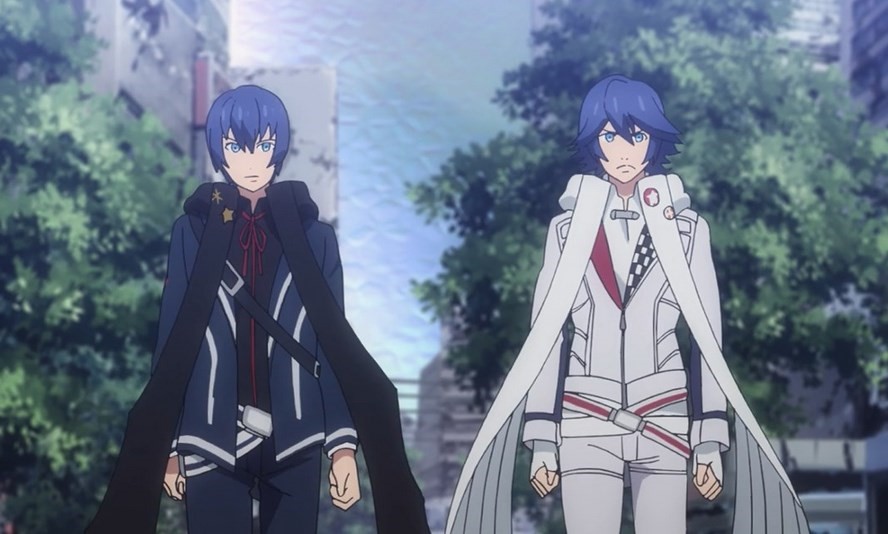This is a show with an interesting concept: what if you had to do battle with an opposing force, bent on destroying your world? What if your opponent was an evil version of yourself? What if you were deemed the evil version and not the other one? That is the initial concept with “Gunslinger Stratos: The Animation” (“Gansuringā sutoratosu Animēshon”). Now, this started out life as a third-person shooter (easily seen amid all the fighting sequences), but morphed into this series.
In the year 2115, the country known formerly as Japan has been split into two parallel worlds: the Frontier S (Stratos) and the 17th Far East Imperial City Management District. Frontier S is an outlaw universe in which freedom runs rampant (damn those freedom seeking radicals!), while the 17th Far East Imperial City Management District is a totalitarian universe, completely bereft of freedom and is under constant surveillance.
While the two universes are just starting to fuse into one, the governments of each world initiates Operation Stratos, a world-scale protocol wherein a handpicked group of gunslingers, mercenaries, street punks and special individuals, each from the two universes, will be sent in the year 2015, to alter the past by eliminating the other side until only one group survives, erasing a parallel universe in the process. No pressure, right?
The story revolves on these group of fighters during Operation Stratos, particularly on a group of four childhood friends: Tohru Kazasumi (that’s both of them up there. In a shift, the ‘good guy’ is in black), Kyōka Katagiri, Kyōma Katagiri, (please note the spelling difference; that is a brother-and-sister team, not any error on my part) and Shizune Rindo, who all must confront their own flaws and differences when they battle their alternate selves in order to survive. Now, if this wasn’t complicated enough, they are beset by a strange disease called “Desert Syndrome” where people abruptly turn into sand and crumble away to nothing.
In trying to figure out how this is happening, Tohru comes across a little purple-haired girl who was writing something on the street. He thought it was art, but instead was a rather complicated formula and the words “Help me”. He then gets shot by himself, but manages to avoid anything fatal. It was then decided that he had to join the team and do battle. The series contends itself with trying to figure out what is going on and how best to resolve these issues.
It is a bit of a workout to start, as you are just as plunked into things as Tohru is and you get the feeling that you are not getting the whole story on things. The interesting thing about the fight sequences is that they are fought interstitially. Huh? The battles are fought in the spaces between time, so they do not do damage to the real world of 2015, although you can be just as easily injured or killed if it was real time and location.
I don’t know how to react to this show. Your doppelgänger is truly your mirror opposite, but I would feel that I could manifest some degree of conversation with me and not have my guns to the talking, save for the occasional “Die, you bastard!”, which really doesn’t help foment conviviality. We also learn of the true machination that undermine all the work that these people are doing and have to come to grips with a new reality that may be a different path of ascent than the one originally laid before us in an unquestioning manner. OK, $10 words to one side, are you willing to question all around you and embrace a response that in not part of the plan? Will you work towards that end? Can you work towards that end?
This is a real thinker of a series, as we have to learn to go beyond revenge and anger and frustration and not merely shoot the crfap out of everyone we see. It’s just, at times, it gets a bit too ponderous for its own good and hurts itself in the process. I wouldn’t write off this series, but I feel it could have been done better, as it really dragged the last three or four episodes. It felt like the plot was complicated, just to complicate the plot and not that the plot complicated itself on its own.
On a scale of 1 to 10:
Artwork 7 (Serviceable)
Plot 8 (Interesting approach)
Pacing 6 (The fights slow it all down)
Effectiveness 7 (As it did not know how to get to where it wanted to be)
Conclusion 7 (It honestly end)
Fan Service 2 (A similar show would be “Okamisan”)
Overall 7 (Crawled to an end)
And remember, it’s first run until you’ve seen it. I will destroy you!

Leave a Reply